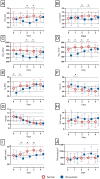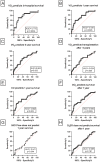Oxygen Consumption Predicts Long-Term Outcome of Patients with Left Ventricular Assist Devices
- PMID: 36986273
- PMCID: PMC10054897
- DOI: 10.3390/nu15061543
Oxygen Consumption Predicts Long-Term Outcome of Patients with Left Ventricular Assist Devices
Abstract
Reduced oxygen consumption (VO2), either due to insufficient oxygen delivery (DO2), microcirculatory hypoperfusion and/or mitochondrial dysfunction, has an impact on the adverse short- and long-term survival of patients after cardiac surgery. However, it is still unclear whether VO2 remains an efficient predictive marker in a population in which cardiac output (CO) and consequently DO2 is determined by a left ventricular assist device (LVAD). We enrolled 93 consecutive patients who received an LVAD with a pulmonary artery catheter in place to monitor CO and venous oxygen saturation. VO2 and DO2 of in-hospital survivors and non-survivors were calculated over the first 4 days. Furthermore, we plotted receiver-operating curves (ROC) and performed a cox-regression analysis. VO2 predicted in-hospital, 1- and 6-year survival with the highest area under the curve of 0.77 (95%CI: 0.6-0.9; p = 0.0004). A cut-off value of 210 mL/min VO2 stratified patients regarding mortality with a sensitivity of 70% and a specificity of 81%. Reduced VO2 was an independent predictor for in-hospital, 1- and 6-year mortality with a hazard ratio of 5.1 (p = 0.006), 3.2 (p = 0.003) and 1.9 (p = 0.0021). In non-survivors, VO2 was significantly lower within the first 3 days (p = 0.010, p < 0.001, p < 0.001 and p = 0.015); DO2 was reduced on days 2 and 3 (p = 0.007 and p = 0.003). In LVAD patients, impaired VO2 impacts short- and long-term outcomes. Perioperative and intensive care medicine must, therefore, shift their focus from solely guaranteeing sufficient oxygen supply to restoring microcirculatory perfusion and mitochondrial functioning.
Keywords: cardiac surgery; intensive care medicine; left ventricular assist device; metabolic and hemodynamic parameters; mitochondrial dysfunction; oxygen consumption; oxygen delivery.
Conflict of interest statement
T.S. consultant and advisor (Medtronic Inc., Abbott Inc. and CorWave), and research grants (Medtronic Inc., Abbott Inc., and CorWave). D.W. proctor and consultant (Abbott Inc.), and advisor (Xenios/Fresenius Medical Care). The other authors declare that they have no competing interests.
Figures



References
-
- McDonagh T.A., Metra M., Adamo M., Gardner R.S., Baumbach A., Böhm M., Burri H., Butler J., Čelutkienė J., Chioncel O., et al. 2021 ESC Guidelines for the diagnosis and treatment of acute and chronic heart failure: Developed by the Task Force for the diagnosis and treatment of acute and chronic heart failure of the European Society of Cardiology (ESC) With the special contribution of the Heart Failure Association (HFA) of the ESC. Rev. Esp. Cardiol. 2022;75:523. doi: 10.1016/j.rec.2022.05.005. - DOI - PubMed
-
- Doulamis I.P., Inampudi C., Kourek C., Mandarada T., Kuno T., Asleh R., Briasoulis A. Characteristics and outcomes of left ventricular assist device recipients transplanted before and after the new donor heart allocation system. Artif. Organs. 2022;46:2460–2468. doi: 10.1111/aor.14363. - DOI - PubMed
-
- Bole I., Rodgers D., Smith B., Nguyen A., Chung B., Kalantari S., Sarswat N., Kim G., Song T., Ota T., et al. Estimated versus actual oxygen consumption in patients supported with lvads. J. Heart Lung Transplant. 2021;40:S449–S450. doi: 10.1016/j.healun.2021.01.1250. - DOI
Publication types
MeSH terms
LinkOut - more resources
Full Text Sources

